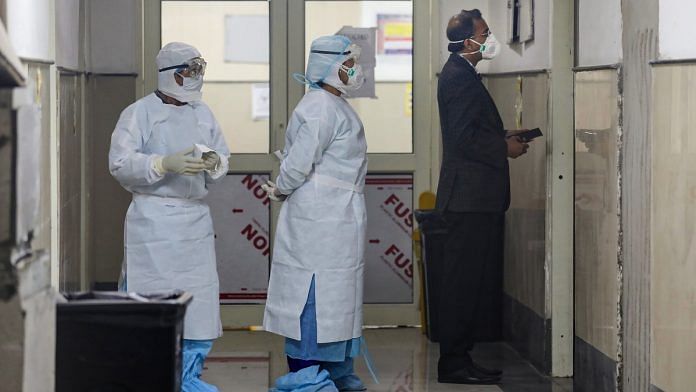New Delhi: A 25-year-old resident doctor at Lucknow’s King George Medical University tested positive for coronavirus on 18 March after coming in contact with two COVID-19 patients.
A day before, on 17 March, a 63-year-old doctor treating the 76-year-old man from Karnataka, who died on 11 March due to the virus, tested positive for COVID-19.
These cases highlight the safety of health workers who are on the frontline of treating patients suffering from the deadly infection.
On Tuesday, when India’s apex research body, the Indian Council of Medical Research (ICMR), updated its testing protocol, it included testing for health workers who have symptoms of acute respiratory illness after caring for patients suffering from severe acute respiratory infections.
“Public hospitals and non-profit hospitals are already struggling with lack of adequate human resources, equipment and funds, the current coronavirus epidemic can push these further into the brink,” said Dr S.P. Kalantri, director & professor of Medicine at Mahatma Gandhi Institute of Medical Sciences (MGIMS) in Wardha, Maharashtra.
In India, the possibility of doctors and healthcare staff contracting COVID-19 is higher because of restrictive testing as only those with travel history and symptoms are being tested, said Dr Deepak Baid, president-elect of the Association of Medical Consultants.
It takes 5-7 days for the first symptoms to appear, until then a patient sheds the virus.
This means not just doctors caring for patients in the intensive care units are at risk, but also family physicians, who are consulted first.
Lack of protective equipment and sanitisers also put them at additional risk.
“We have been struggling to procure enough stocks of masks and sanitisers for our hospitals,” said Baid.
He said they do have stock for a few weeks, after which they would need the government’s intervention to ensure supply of protective equipment.
Also read: How to slow down COVID-19 — this is the only way to ‘flatten the curve’ of coronavirus spread
How doctors get exposed to COVID-19
The doctor treating the Karnataka patient, who was India’s first COVID-19 fatality, was a retired government doctor who visited the patient at his home and was treating him since 6 March.
He quarantined himself only on 11 March after the death of the patient. The doctor, his family and 370 of the patient’s contacts have been quarantined.
In this case, the patient’s samples were confirmed to be positive for COVID-19 only after his death.
In Mumbai, the 64-year-old patient, who didn’t reveal his travel history to Dubai, was admitted in the intensive care unit of Hinduja Hospital on 9 March.
After his condition deteriorated and he tested positive for COVID-19, as many as 82 staff members who were exposed to the patient, including doctors, had to be quarantined. The patient later died at Kasturba Hospital, Mumbai, on 17 March.
Fear gripped doctors at MGIMS when a 37-year-old male patient was admitted in the intensive care unit with severe pneumonia and kidney failure. He required ventilation too.
Since the patient did not have a travel history to coronavirus-hit countries, his sample was not tested initially by the regional lab, Indira Gandhi Government Medical College. However, it was tested a day later and found to be negative.
“Our whole team could breath a sigh of relief,” said Dr Kalantri. Not knowing the status of the patient would have added to the stress of the staff already treating the sickest of patients, he added.
Also read: ‘Need people to cooperate’ — officials defend chaos at Delhi airport over COVID-19 screening
Health workers at risk during community spread
The virus is yet in its second phase of transmission, restricted to the contacts of those who have a travel history, and is not getting spread in the community, ICMR scientists have said.
If there is a community spread, the first ones to be affected will be health workers.
Also long hours of work, psychological stress and fatigue increase the risk of catching the infection.
Health workers getting infected and remaining quarantined adds strain to the overstretched healthcare system during an epidemic.
In China, 1,716 health workers tested positive for coronavirus with six deaths. Around 87 per cent of them were from Hubei province itself.
In Italy, where the number of deaths due to coronavirus has gone beyond 2,500, doctors and hospitals are overwhelmed by the number of patients, and are working day and night, and often sleeping in the hospitals.
Doctors are even forced to decide which patients to attend to and which ones to ignore.
Hospitals preparing wards
According to the World Health Organization, it is the responsibility of the manager and employers to ensure that preventive and protective measures are taken to minimise occupational and health risks.
While the hospitals have been taking stock of masks, gloves, personal protective equipment, they are also training health workers to take precautions.
“Not just doctors and nurses, sanitation workers, drivers, ward boys, ambulance workers need to be trained at how to reduce transmission,” said Karan Madan, assistant professor, department of pulmonology, AIIMS, New Delhi.
He said AIIMS had conducted training sessions on hygiene, infection control as part of their preparedness.
To minimise exposure, hospitals in Mumbai have been asked to separate patients who have travel history from other patients.
Even at the 924-bedded MGIMS, five isolation beds and two ICU beds with dedicated nurses have been set up to treat coronavirus patients.
Also read: Facebook wrongly blocks coronavirus news as spam but it’s not the first time




Stay home
Corona virus is very complected..so stay in home & protect own and world’